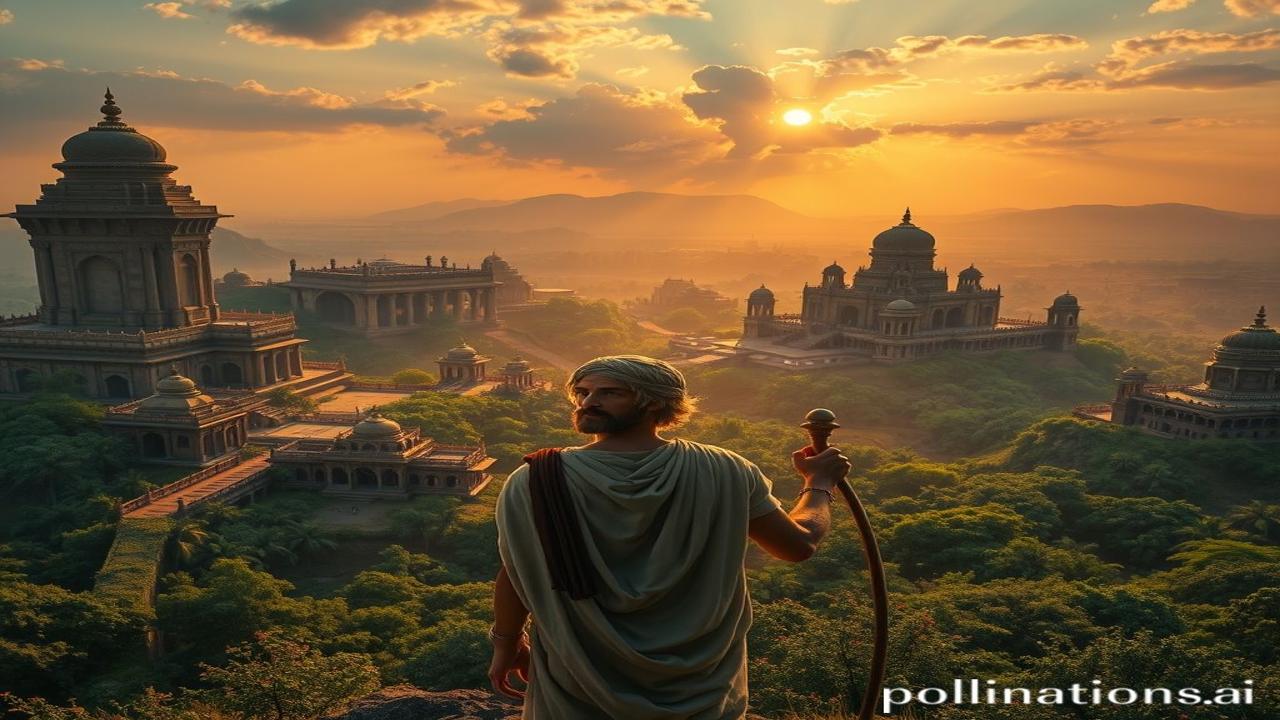Waqt ki dhool mein chupi ek videshi aankhon ki kahani – Megasthenes’s India!
Kabhi socha hai, aaj se 2300 saal pehle, ek Greek diplomat ne Hindustan ko kaise dekha hoga? Imagine, a foreigner stepping onto Indian soil for the first time, his eyes wide with wonder, taking in the sights, sounds, and smells. This is the story of Megasthenes, a Greek ambassador who painted a fascinating picture of India during the reign of Chandragupta Maurya. Let’s dust off the pages of history and see what India looked like through his eyes!
The Greek Gaze: Megasthenes and the Mauryan Empire
Megasthenes was a Greek ethnographer and ambassador sent by Seleucus I Nicator, a successor of Alexander the Great, to the court of Chandragupta Maurya in Pataliputra (modern-day Patna) around 302 BCE. Now, why is this important? Well, his accounts, though fragmented and existing only in excerpts quoted by later authors like Strabo and Arrian, are some of the earliest and most comprehensive descriptions of India available to the Western world. He gave the Greeks (and us!) a peek into the heart of the Mauryan Empire, its society, its customs, and its glory. Think of him as the first real “India travel blogger” – but with a diplomatic mission!
“Indika”: Lost But Not Forgotten
Megasthenes wrote a book called “Indika,” which sadly is lost to time. We only know about its contents through fragments cited by other Greek and Roman writers. Imagine how much richer our understanding of that era would be if the original survived! But even these scattered pieces offer invaluable insights. He described a land teeming with prosperity, impressive organization, and unique customs. His work shaped the Western perception of India for centuries.
ज़मीनी सच – Life under the Mauryas: Rulers, Farmers, and Ascetics
Let’s step into Megasthenes’s shoes for a moment. Picture Pataliputra, a sprawling city enclosed by a wooden palisade, protected by hundreds of towers and gates. Imagine the grandeur of Chandragupta’s court, the sheer scale of the Mauryan army, with its elephants, chariots, and infantry.
Megasthenes was particularly impressed by the Mauryan administration. He wrote about a well-organized bureaucracy responsible for everything from collecting taxes to managing irrigation. He described the king surrounded by guards and advisors, a symbol of power and stability.
He also marveled at the different castes (jati) he observed, emphasizing their hereditary nature and the strict divisions of labor. He described philosophers (brahmins), farmers, soldiers, artisans, and merchants, each playing their part in the social fabric. “Farmers,” he noted, “never raided the fields of their neighbours.”
One of the most interesting things he pointed out was the lack of written laws. He wrote that society was governed by customs and traditions, passed down through generations. This suggests a strong emphasis on oral traditions and community values.
“Sannyasis” and their austere lives
Megasthenes was also fascinated by the ascetics and hermits, the sannyasis, who renounced worldly possessions and sought spiritual enlightenment. He admired their simple lives and their dedication to philosophical pursuits. He noted that some were naked, and lived alone in jungles; others gathered together, and preached.
धरोहर और पहचान – Echoes of Megasthenes’s India in Today’s Bharatiyata
The influence of Megasthenes’s observations can still be felt in some ways today. The emphasis on family values, respect for elders, and the importance of dharma (righteous conduct) are still integral parts of Indian culture. While the rigid caste system is officially outlawed, its vestiges unfortunately linger in certain aspects of society. The concept of seva (selfless service), which he observed in the Mauryan administration, continues to inspire many Indians. The value placed on knowledge and spiritual pursuits remains a cornerstone of Indian thought. The idea of dharma, as a guide to righteousness, has been and will always be, a part of Bharatiyata.
मजेदार तथ्य या भ्रम-भंजक – The Rivers of Gold?
Fun Fact: Megasthenes claimed that India was incredibly rich and that some rivers even contained gold! While this might be an exaggeration, it reflects the perception of India as a land of immense wealth and abundance, which drew traders and conquerors from across the globe. The real gold, of course, was in the richness of its culture and the resilience of its people.
Myth-Buster: Megasthenes’s accounts aren’t without their limitations. As a foreigner, he may have misinterpreted some aspects of Indian society. Some scholars question the accuracy of certain details, suggesting that he may have relied on hearsay or exaggerated accounts.
दृश्य और भावनाएं – A Sensory Journey to Mauryan India
Imagine the air thick with the scent of spices from bustling markets. Picture the cacophony of sounds – the clatter of chariots, the chanting of priests, the music of flutes and drums. Feel the smooth coolness of polished stone in the Mauryan palaces. See the vibrant colors of the silk and cotton garments worn by the people. Taste the sweet, syrupy desserts offered at street stalls. The visual and sensory landscape of Mauryan India, as glimpsed through Megasthenes’s eyes, is truly captivating.
अंतिम विचार या उद्धरण – A Foreign Gaze, an Enduring Legacy
Megasthenes’s account, despite its limitations, provides a valuable window into ancient India. It reminds us that even through the eyes of a foreigner, the richness and complexity of Indian culture shone through. It’s a reminder that India’s story is not just one of kings and battles, but also of people, their dreams, and their enduring spirit.
“Atithi Devo Bhava” – The guest is equivalent to God. This timeless Indian principle reflects the welcoming spirit that perhaps greeted Megasthenes himself, allowing him to glimpse the glory that was Mauryan India.
